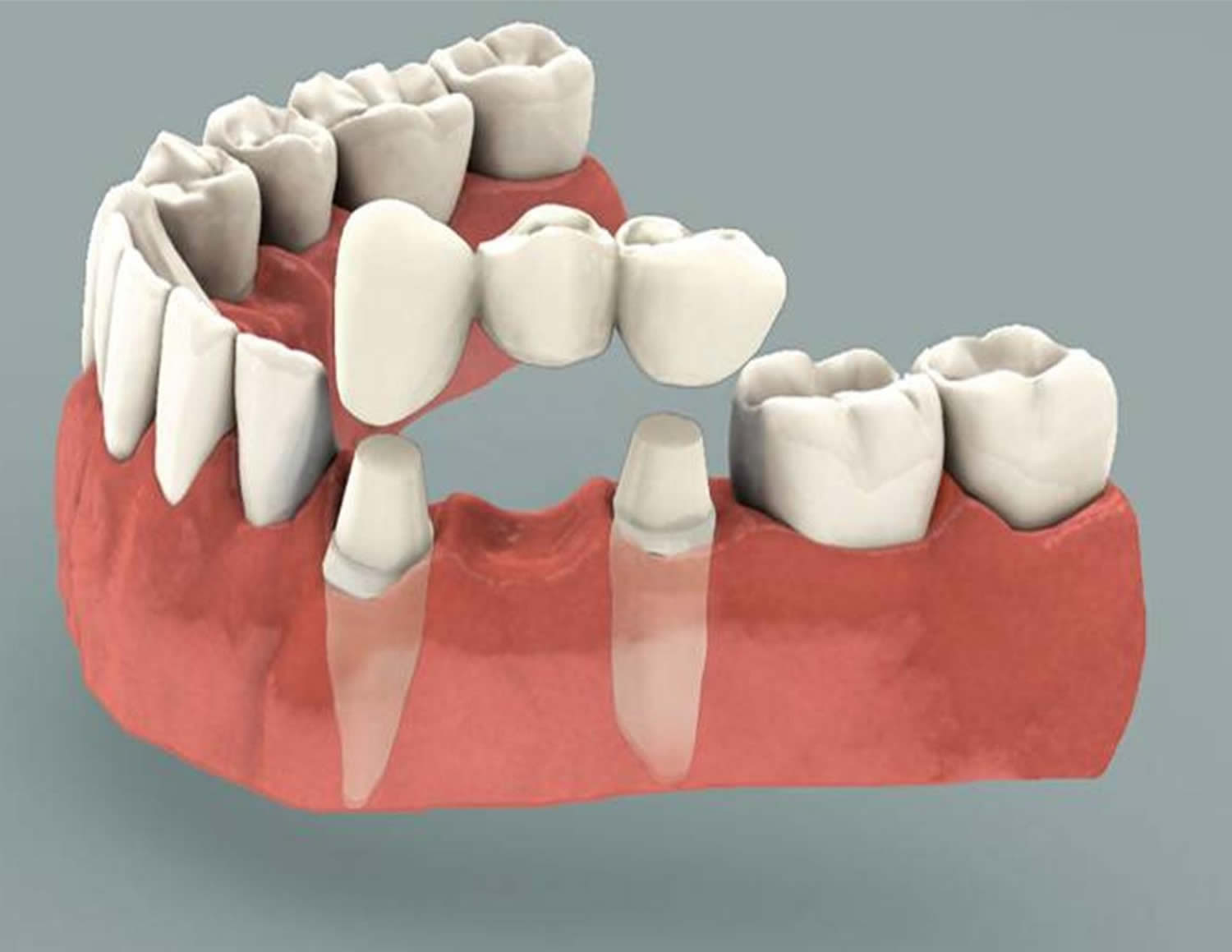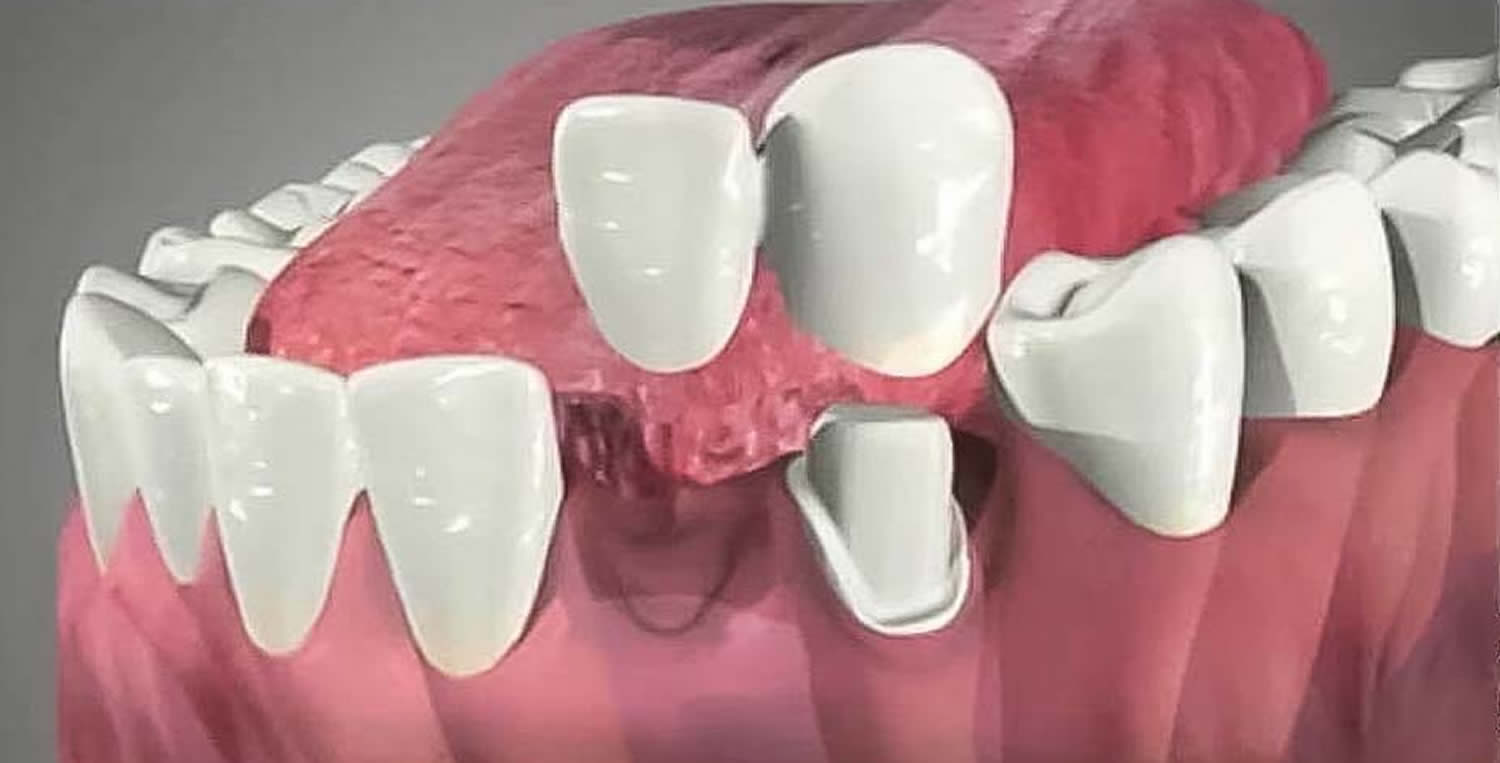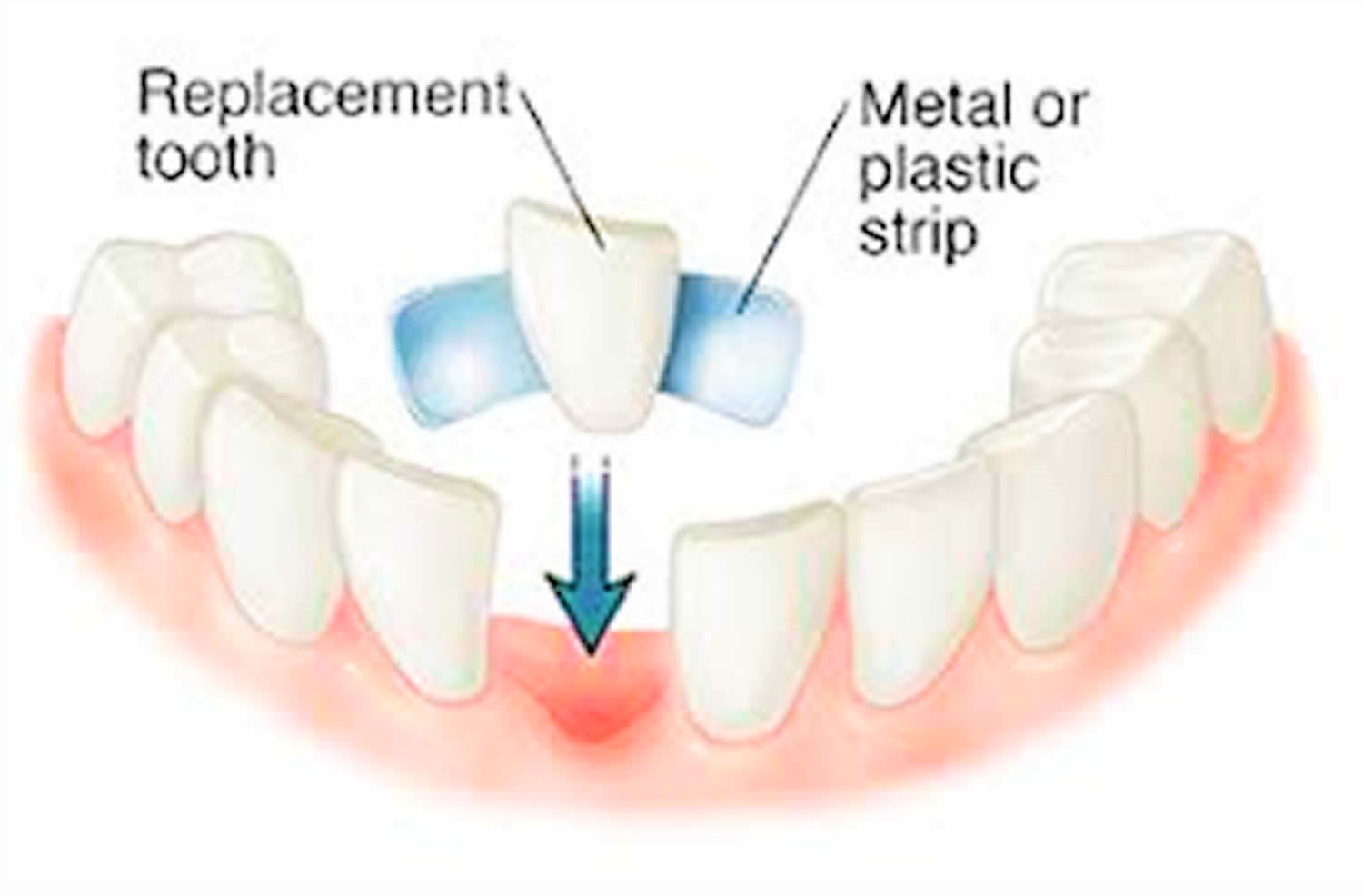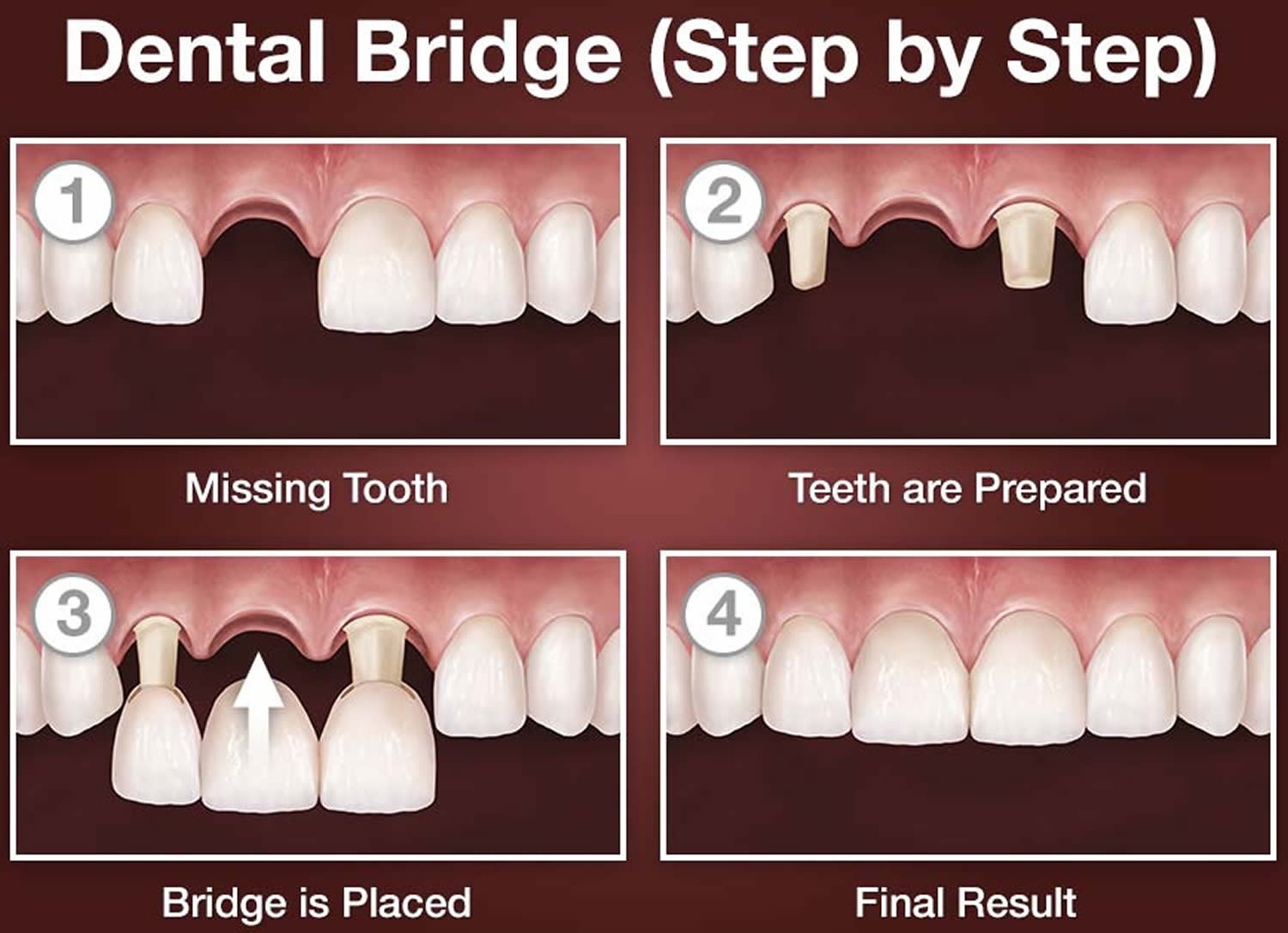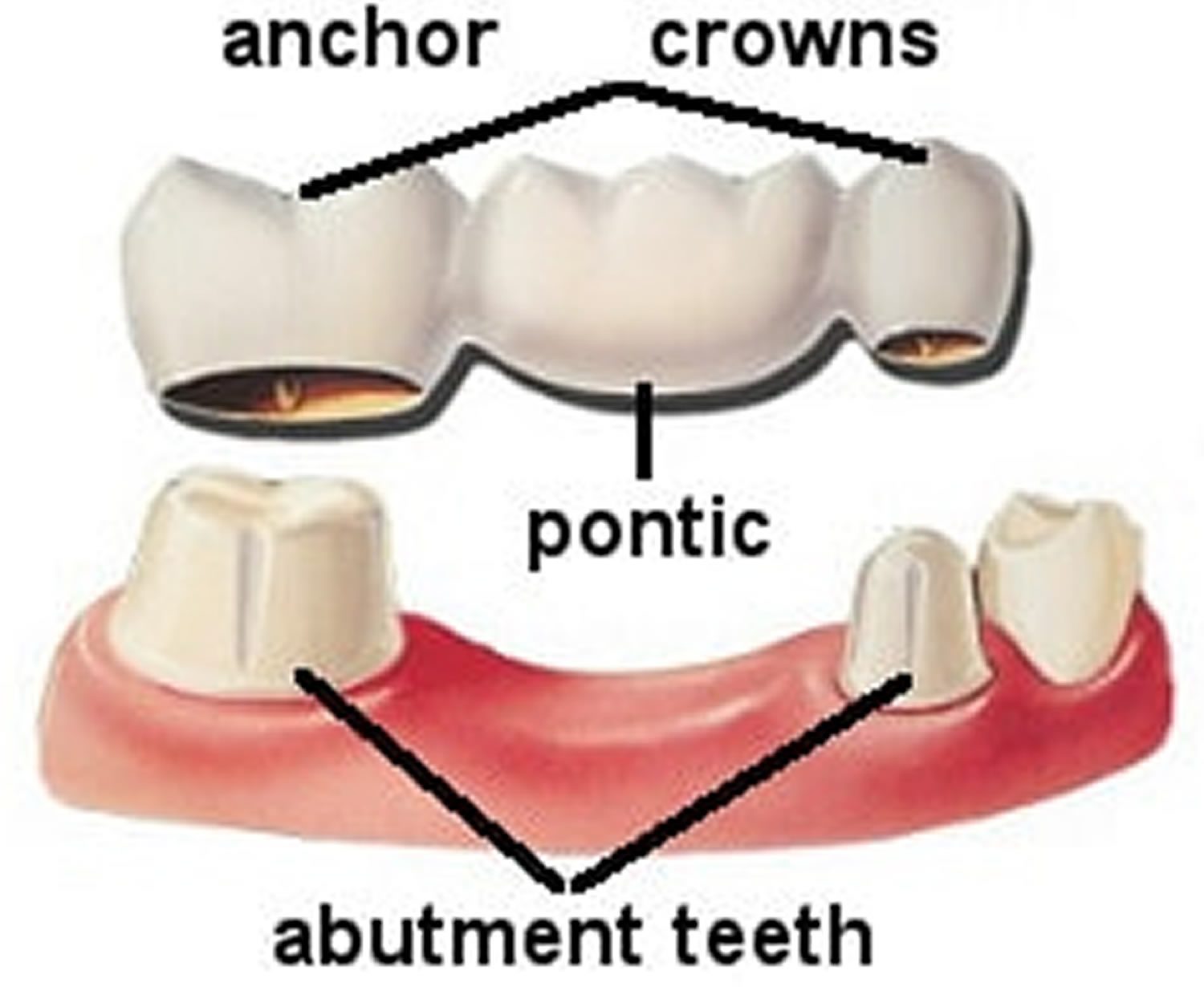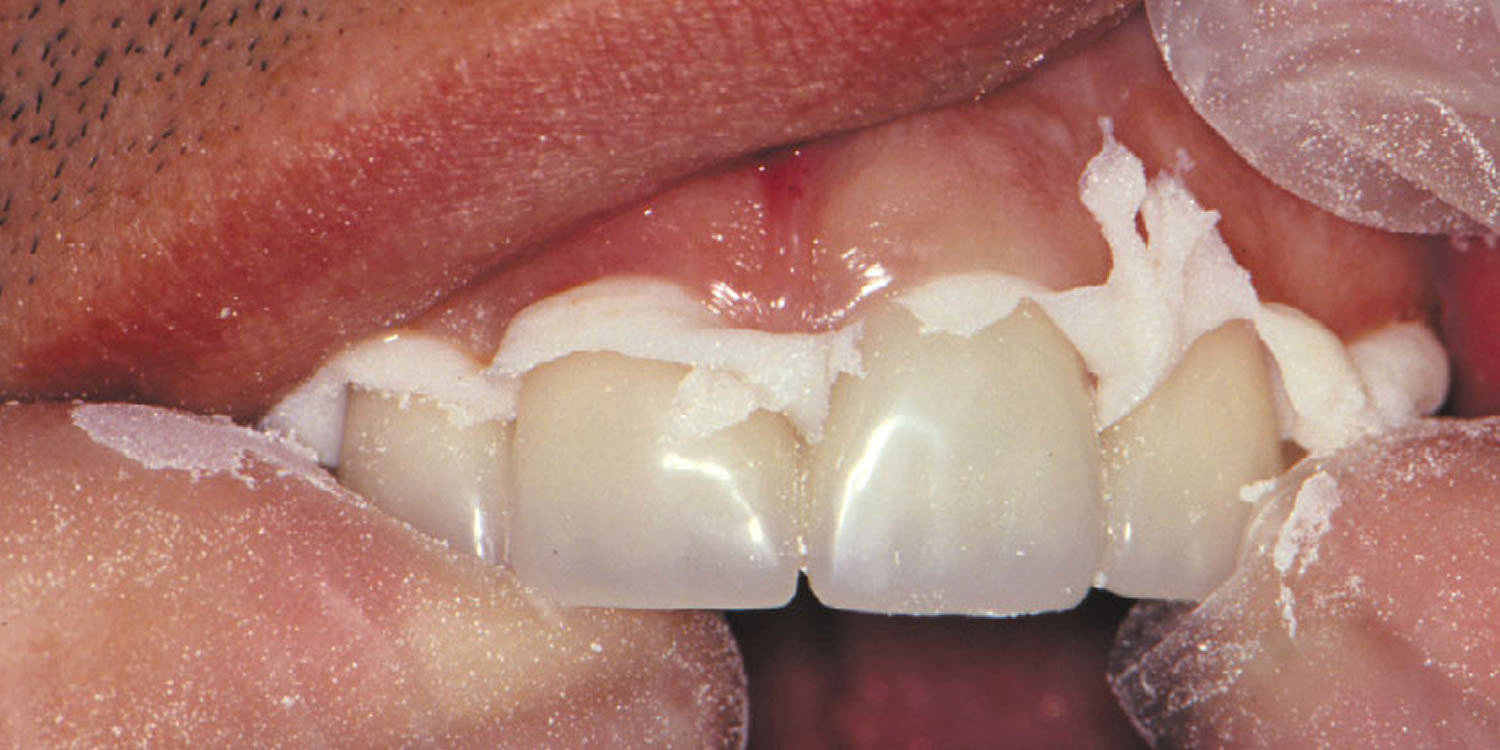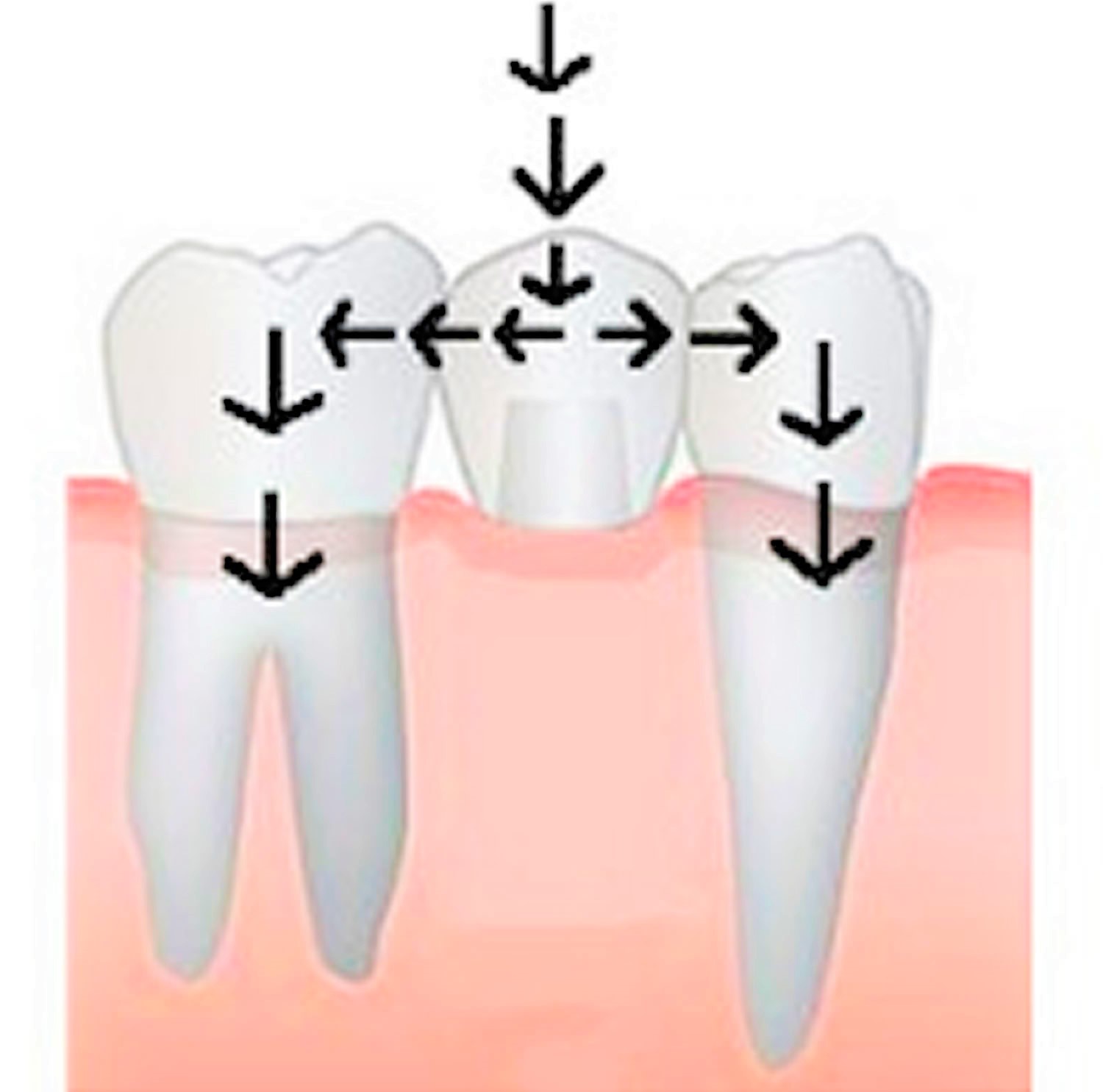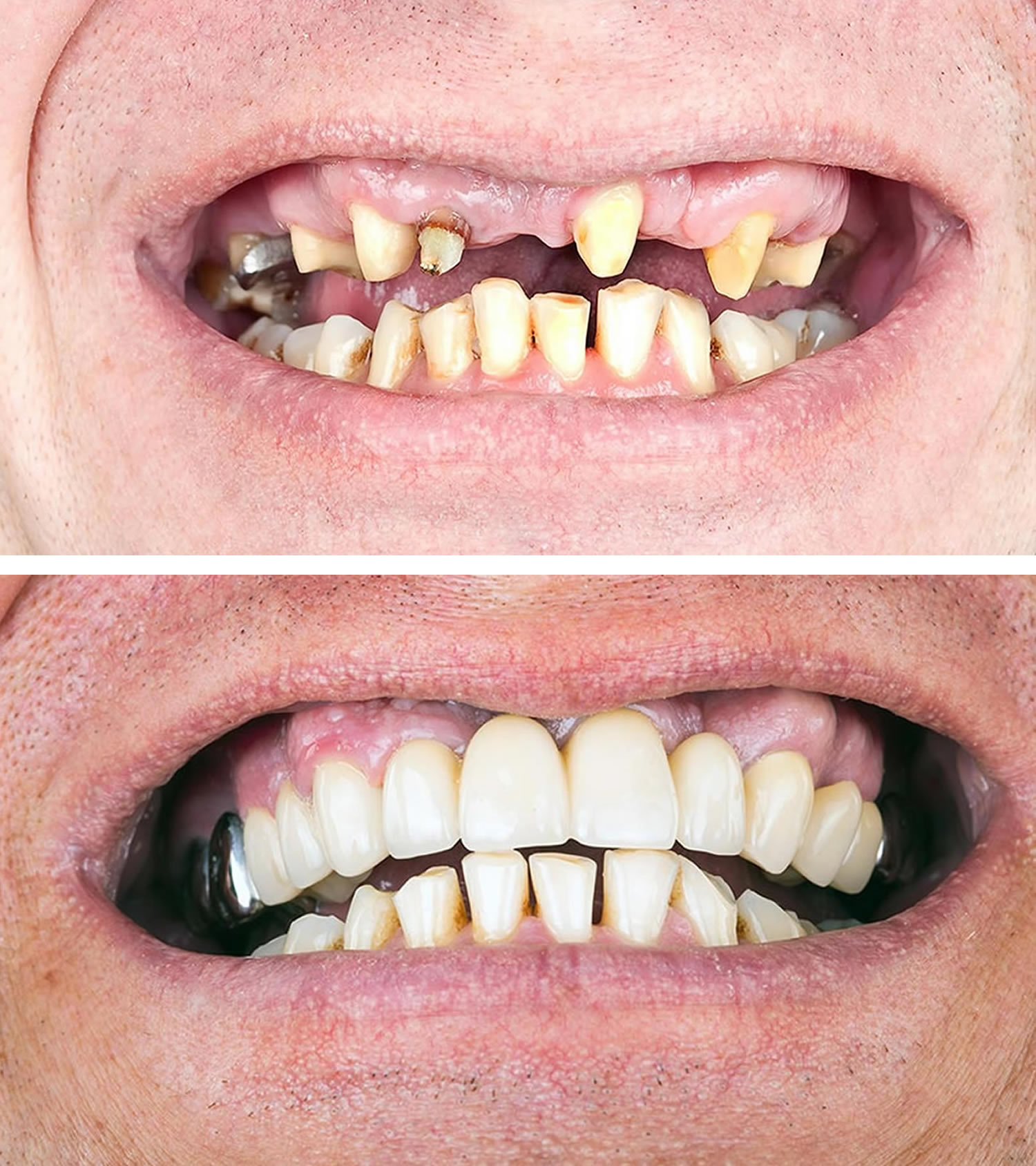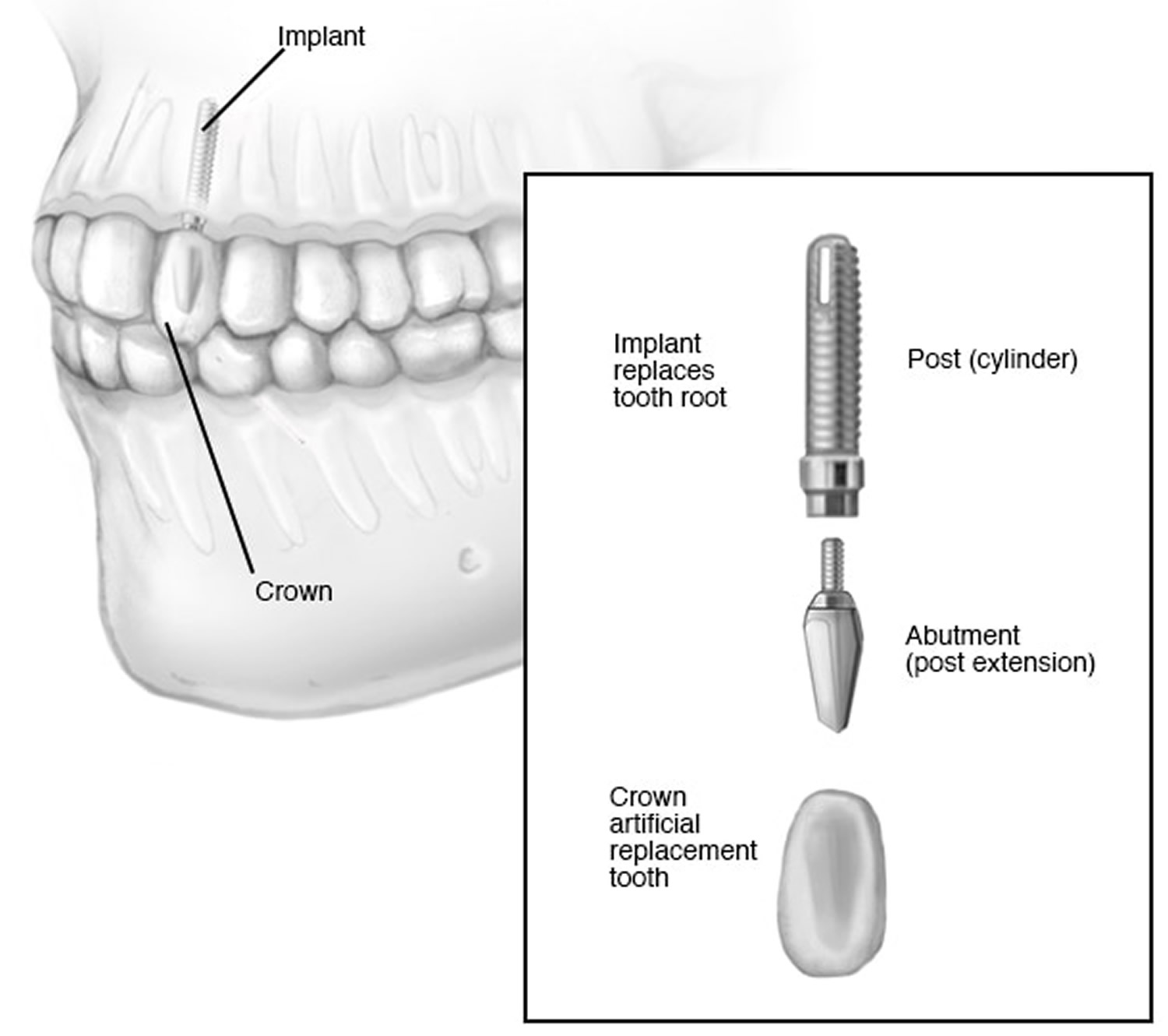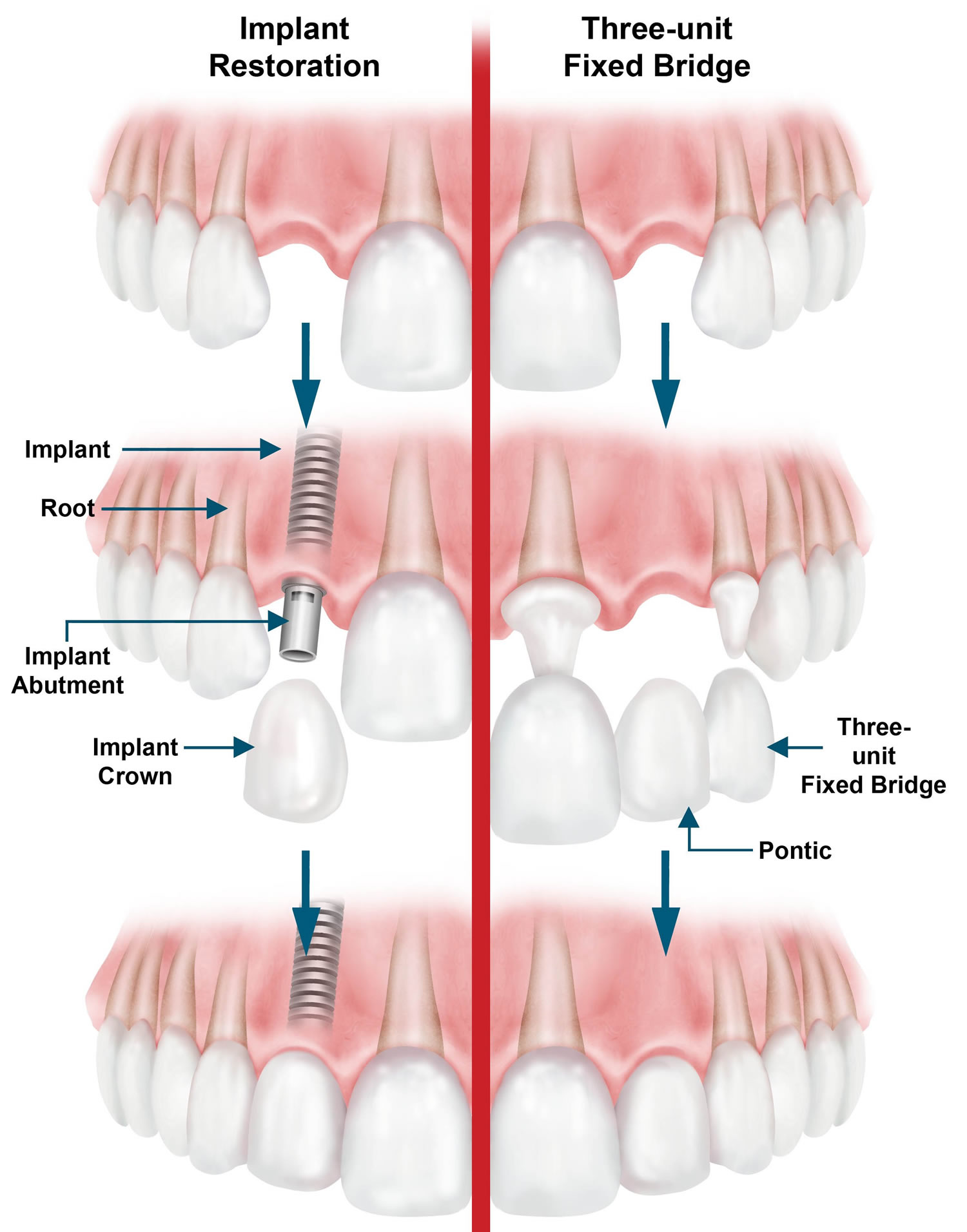Contents
- What is dental bridge
- Types of Dental Bridges
- Dental bridge procedure
- How does a dental bridge work
- Dental bridge vs implant
- When might a dental implant be needed?
- What happens if the dental implant does not fuse with the bone?
- Are dental implants safe?
- What are alternatives to dental implants?
- Are the implant teeth difficult to clean?
- Can I take the teeth out if they are fixed to implants?
- Do dental implants hurt?
- Can dental implants always be used to replace missing teeth?
- I have some of my own teeth. Can I still have dental implants?
- If I had gum disease when I had my own teeth, will I get it with the dental implants?
- How long does the dental implant treatment take?
- Do dental implants last?
- What if I want “metal-free” implants?
- Can dentures be made into implants?
- Are dental implants removable like dentures or do they stay in your mouth?
- What do I do if the screws in the denture are loosening?
- What if I have an accident?
- What are the disadvantages of dental implants?
- How much do implants cost and does insurance cover the cost?
- What is the success rate of dental implants?
- Dental implant process
- Dental implant surgery
- After the dental implants procedure
- Dental implant complications
What is dental bridge
A dental bridge is a fixed replacement for a missing tooth or teeth when the adjacent teeth are strong enough to support the missing tooth. A dental bridge is a fixed dental prosthesis (replacement part) used to replace one or several missing teeth by permanently joining an artificial tooth to adjacent teeth or dental implants. A dental bridge is a prosthesis that relies on support from healthy teeth surrounding the gap left by a missing tooth or teeth. The artificial replacement tooth is called a “pontic” after the French “pont” for bridge. The healthy adjacent teeth, called abutments, provide support on either side — just like a bridge spanning a canyon. In order for the abutment teeth to provide this crucial support, they must be crowned or “capped.” The process for doing this is the same as if these teeth needed crowns for any other reason — trauma or significant decay, for example. First, the abutment teeth are “prepared” by removing their enamel thereby creating enough space for the crown to fit over and completely cover them while maintaining a lifelike appearance. The crowns on the abutment teeth will be attached to a false tooth (pontic) in between. The pontic also called dummy or artificial tooth, is really just another crown; the difference is that it has no tooth underneath. Normally, the pontic is placed between the abutment teeth (with the exception of the cantilever bridge) and is permanently joined to the anchor crowns. A bridge can have one or more pontics depending on the number of gaps to be restored and the number of missing teeth.
Dental bridges are non invasive procedures that only require a local anaesthetic.
Dental bridges come in three types: conventional fixed bridges, cantilever bridges and resin-bonded bridges. Dental bridge restores your bite and helps keep the natural shape of your face. A dental bridge can be made of:
- porcelain bonded to metal alloys, which may contain gold, silver, nickel, chromium, titanium and molybdenum
- metal alloys containing cobalt chromium, titanium, aluminium and vanadium
- acrylic (plastic) for temporary bridges
- porcelain
Dental bridges may also be made of other non-metallic materials. You should ask your dentist what is most suitable for you.
Placing a dental bridge usually takes more than one dental visit. On the first visit, your dentist prepares the teeth on both sides of the gap. He or she will later attach the bridge to these teeth.
Your dentist then takes an impression or an image of your teeth and the space and sends it to a dental laboratory. Technicians at the lab make the bridge. Your dentist will place a temporary bridge to protect your prepared teeth while you are waiting for the permanent bridge.
When the permanent bridge is ready, the dentist fits, adjusts and cements the bridge to the prepared teeth. This type of bridge is permanent and cannot be taken out of your mouth without a dentist’s help.
Fixed dental bridges, however, are not the perfect solution for missing tooth and often bring with them a number of other problems. Despite dental bridges can last for many years if they are cared for properly. However, dental bridge can fail, usually due to decay of the natural teeth next to them, or failure of the cement.
Disadvantages of fixed dental-bridge
A dental bridge may require the cutting down of healthy, adjacent teeth that may or may not need to be restored in the future. Then there is the additional cost of possibly having to replace the bridge once, twice or more over the course of a lifetime. Of even greater concern, fixed bridges often affect adjacent healthy teeth, and may suffer bone loss in the area where the tooth or teeth are missing. Recurrent decay, gum disease and wear and tear often doom fixed bridgework to early failure. For these reasons, fixed dental bridges usually need to be replaced every seven to 15 years. Studies show that within five to seven years there is a failure rate of up to 30% in teeth located next to a fixed bridge or removable partial denture.
- Requires enamel removal of adjacent healthy teeth
- The abutment teeth may show increased sensitivity to external stimuli
- If adjacent teeth have crowns, they must be redone
- Tooth decay is a potential problem
- Root canal treatment may be required if nerves are affected
- Greater tendency for gum disease
- Less longevity than dental implants
Bridges require the preparation of the abutment teeth
To ensure the bridge support and insertion, the abutment teeth need to be properly prepared. This operation involves permanently removing much of the tooth’s original structure, including portions that might still be healthy and structurally sound. This disadvantage stands out especially when abutment teeth are perfectly healthy without any fillings or cavities.
It’s the biggest disadvantage as it leads to the loss of large amounts of healthy tooth tissue and sometimes even tooth devitalization and endodontic treatment. Therefore, restorations supported exclusively by dental implants have the big advantage that teeth adjacent to the gap remain untouched.
The abutment teeth may show increased sensitivity to external stimuli
Usually, after the preparation, one or more temporary crowns are constructed. These devices will protect the abutment teeth until the definitive restoration is completed.
If no temporary restoration was designed, abutment teeth may show an increased sensitivity to hot or cold stimuli until the bridge is definitively cemented.
Reasons for getting a dental bridge
A missing tooth is a serious matter. Teeth are made to work together. When you lose a tooth, the nearby teeth may tilt or drift into the empty space. The teeth in the opposite jaw may also shift up or down toward the space. This can affect your bite and place more stress on your teeth and jaw joints, possibly causing pain.
Teeth that have tipped or drifted are also harder to clean. This puts them at a higher risk for tooth decay and gum disease.
When a tooth is missing the bones begin to shrink and change the shape of your face. If that happens, it may change the way the jawbone supports the lips and cheeks. Over time, this can make your face look older. All of this can be prevented if the tooth is replaced quickly.
You might need a dental bridge if you have a missing tooth or teeth and have healthy teeth on either side of the gap left by the missing teeth.
Alternatives to dental bridges
The main alternative to a dental bridge is using removable false teeth, known as a partial denture, which you can take out to clean. Another alternative is a dental implant. Dental implants refer to permanently integrating artificial tooth roots in the bone structure of missing teeth. While it provides a permanent, durable and fool-proof solution, all patients may not be suitable candidates for implant surgery. Problems associated with bone density or gum recession may prevent an individual from being able to get implants.
Dentures, involve the restoration of missing teeth through removable partial of full artificial replacements. While it is a low cost alternative to dental bridges or implants, it does not provide as permanent and natural looking a solution. Moreover, dentures may be uncomfortable and can cause problems in speech and chewing or condition of sore gums.
Who should avoid undergoing a dental bridge?
Pregnant women are ideally asked to avoid elective dental procedures during pregnancy. While local anaesthetics are used in these procedures, dentists normally recommend getting bridges after delivery to avoid any complications due to the anesthesia.
If a patient has more than one tooth missing, it is better to opt for dentures or implants, as bridges require adjacent tooth to be of good health as well.
Caring for your Dental Bridge
Good dental hygiene is extremely important as the teeth underneath the crowns and bridge are vulnerable to plaque and decay. To ensure your bridge’s lifespan of more than ten years, make sure you brush twice a day with a soft-bristled toothbrush with fluoride toothpaste and floss, as is usually recommended for natural teeth.
Your dentist will also show you how to effectively clean your bridge along with the rest of the mouth while you are in the surgery. Your dentist also suggest avoiding hard, sticky snacks such as toffee, caramelised nuts and popcorn.
Post-operative diet for a dental bridges
- You should avoid sticky food items like jellybeans or gummy bears, etc. These food items stick in between the bridge and the opposite tooth. Thus, when the opposite chewing motion between the two might pull out the dental bridge as it is not permanently anchored into gums.
- Crunchy foods like carrots should not be taken as these might damage the tooth under the crown.
- Sugary foods should also be prevented as these lead to decay of gums and teeth at and near the bridge site.
- Hot and cold foods can also be avoided to prevent sensitivity.
In case of dental bridges, the postoperative diet is almost as same as that for dental crowns because bridges contain dental crowns as crowns form a part of the bridge. Food items with excess of sugar content can cause decay under the crowns and therefore, should be avoided.
Types of Dental Bridges
Dental bridges are made up of one or two crowns on either sides of an artificial tooth. The artificial tooth is called is called a pontic and is made from gold, porcelain, etc. The anchoring teeth on the side are called abutment teeth. Bridges are generally supported by natural teeth or implants. They can be of different kinds –
Traditional dental bridges
Traditional bridges, generally made up of ceramic or porcelain materials are of the basic design that is two crowns with a pontic in between. This is the most common dental bridge.
Cantilever dental bridges
Cantilever bridges are dental bridges that are designed when abutment teeth are prepared on only one side of the missing toothless gap. In such cases, the pontic is located outside the abutment teeth. Cantilever bridges are not preferred at the back of the mouth.
When can such circumstances occur?
- when, for aesthetic reasons, it is not desirable to prepare teeth on both sides of the breach
- when no teeth exist on one side of the breach
- when the eligible abutment teeth on one of the sides is already supporting another prosthetic restoration that, for various reasons, cannot be replaced
Cantilever dental bridges involve increased, of the axis forces that will act on the abutment teeth.
Therefore, cantilever bridges should be carefully planned; otherwise, there is the risk of jeopardizing abutment teeth stability.
There are two types of cantilever bridges:
1) Cantilever bridge with the pontic placed towards the front of the mouth
This means that the gap is located in front (or anterior) of the abutment teeth. It is the favorable situation from the two because chewing pressures decrease as we advance towards the front of the mouth.
However, chewing forces are still acting outside the axis of the bridge, hence putting additional pressures on the abutment teeth. Therefore, the design should follow certain rules:
- The pontic should only have a single artificial tooth (only one tooth should be replaced)
- The prudent approach is to design a cantilever bridge when the missing tooth is either a premolar or a lateral incisor and only in limited situations if other teeth are missing.
- Generally, at least two abutments are needed to support the bridge (although there are some exceptions if the abutment tooth is a strong canine or molar).
- If your dentist need to replace a premolar or molar, he/she must take into consideration that chewing pressures are higher on the lower arch.
Indications
There are two clinical situations when these restorations may be indicated:
- When, for aesthetic reasons, it is not desirable to prepare a tooth located in a visible part
The first upper premolar is missing and the canine located at the front end of the gap is healthy and undamaged. For obvious aesthetic reasons, your dentist want to leave this tooth untouched.
In this situation, dentist can design a cantilever bridge with the second premolar and the first molar as abutments. These teeth are less visible compared to the canine and the aesthetic appearance will be somehow improved.
The best solution for this particular case is a single dental implant which will avoid the need of preparing any teeth. Although this is very true, not everyone can afford such a restoration (or, in some places, there may be no technical capabilities for dental implants).
- When the anterior abutment tooth is already sustaining another prosthetic restoration that, for various reasons, cannot be replaced.
2) Cantilever bridge with the pontic placed towards the back of the mouth
The toothless gap is located behind (or posterior) the abutment teeth. The chewing forces are much higher in the back part of the mouth. Consequently, the chewing forces that act on the abutment teeth, besides being of the axis, are also extremely high.
After a shorter or longer period of time, abutment teeth may become loose which may jeopardize the entire restoration.
Indications
There are few situations when these types of restorations may be indicated:
- temporary restorations
- if back teeth are missing and patients do not want (or cannot afford) more expensive restorations: removable dentures, dental implants
The lifespan and prognosis of these restorations are usually very short. With the development of dental implants, such solutions are rarely used.
Figure 1. Cantilever dental bridges
Maryland dental bridge
Maryland dental bridge, also known as resin-bonded bridge is usually made up or porcelain or porcelain-fused metal framework where the pontic (false tooth) is attached to the metal or porcelain wings that are cemented to the two abutment teeth. Maryland dental bridge, is a conservative alternative to a traditional bridge. It generally contains plastic teeth, supported by a metal frame which is then bonded to only a single neighbor tooth.
Figure 2. Maryland dental bridge
Dental bridge anchored with inlays
Instead of retainer crowns, this bridge has two inlays attached to the pontic. The inlays will be cemented to the abutment teeth in specially prepared cavities inside the teeth.
Aesthetics is excellent but it lacks stability; thus, it can only be used when a small restoration is designed.
Implant supported bridges
These bridges are supported by dental implants inserted into the jawbone. They are widely used nowadays and are extensively discussed in the chapter about dental implants.
Bridges with special attachments
Because the bridge must be able to fit onto the abutment teeth simultaneously, the taper of the abutment teeth must match, to properly seat the bridge. This is known as requiring parallelism among the abutments.
When this is not possible, an attachment may be used, so that one of the abutments may be cemented first, and the other abutment, attached to the pontic, can then be inserted.
Dental bridge procedure
Building a dental bridge
Securing your dental bridge will usually take more than one trip to the dentist. On your first visit, your dentist prepare your teeth (abutment teeth) on either side of the gap as the bridge will be attached to these teeth. To prepare for a dental bridge, your dentist will usually file down the 2 healthy teeth on either side of the gap, using local anesthesia to minimize any discomfort from drilling. Because three-dimensional models of your teeth are needed to construct the crowns, your dentist will then take an impression of your teeth to make your bridge using a putty-like impression material or he/she may use digital scanning equipment and send the impression off to a dental laboratory. The 3D models of your teeth your dentist create will aid the dental laboratory technicians who will actually make your crowns. While your bridge is being developed your dentist will place a temporary bridge to protect your exposed teeth. If so, that is taken out once your permanent bridge has been prepared.
Depending on your unique situation, dental technicians at the lab make your dental bridge using a combination of metal, ceramics and glass-ceramics.
When your new bridge is ready, your dentist will fit the dental prosthesis (replacement part) to your prepared teeth (abutment teeth) making any adjustments before bonding with a high-tech cement. The dental bridge is now permanent and quickly feels like a natural part of your mouth. Or your dentist might anchor your bridge with a dental implant, which is surgically placed in your jaw. Your dentist will need to check if dental implants are suitable for you.
A brief transition period may follow, during which you become accustomed to the feel of the new dental bridge against your tongue, lips, and cheeks, and accept it as your own teeth.
Figure 3. Dental bridge procedure
Figure 4. Dental bridge components
Post-operative care for a dental bridge procedure
- Chewing with the side on which the treatment was done should be minimized. Instead, try to shift the load on the opposite side.
- As an after care measure, avoid chewing hard foods as these might displace the dental bridge from its correct position.
- Be careful while cleaning or flossing your teeth during the stages of healing of the dental bridge as the floss could pull out the temporary bridge.
- Sticky foods can pull out a temporary dental bridge from its proper position and thus should not be taken immediately after the treatment and for a few days afterwards.
- You should not take any alcoholic beverages or smoke for a few days after the treatment as they disrupt the blood flow to the gums and increase the the healing time.
- Regular cleaning of teeth is necessary as the dental bridges do not decay but the teeth underneath can.
How does a dental bridge work
If you have one missing tooth, your bridgework will require three crowns. Two of those crowns will cover abutment teeth on either side of the gap left by the missing tooth. These two crowned abutment teeth will then become supports for a third crown placed in between them, filling in the empty space. This arrangement is known as a three-unit bridge.
If more than one tooth is missing, more crowns will be needed to bridge the gap in between the abutment teeth; in fact, more abutment teeth may also be needed. There are several variables to take into account in this calculation: the number of missing teeth, the size and length of the abutment tooth roots, the amount of bone support each abutment tooth has, as well as where in the mouth the teeth were lost.
For example, if you have three missing teeth, four abutment teeth may be necessary, thereby creating a seven-tooth bridge. Engineering and designing the bridge requires an understanding not only of how to replace teeth, but also of the biology of tooth-supporting gum and bone tissue.
A dental bridge consists of two components:
Anchor crowns
The anchor crowns (also known as retainer crowns) are two (or more) dental crowns that are cemented on the teeth adjacent to the toothless gap to support the bridgework restoration.
The two anchoring teeth are called abutment teeth. A traditional bridge is supported by natural teeth (or by post and cores when remaining tooth structure is inadequate).
Pontics or artificial teeth
The artificial (or false) teeth are placed between the anchor crowns and basically replace the missing tooth or teeth. Depending on the clinical situation and the number of missing teeth, a dental bridge can have one or more pontics.
A dental restoration made off several dental crowns joined together but without any pontics (because there are no missing teeth) is also considered as a dental bridge.
Dental bridges have two major functions
- Restoration of the missing teeth
- Prevent the complications that can occur after one or more teeth are lost
Restoration of the missing teeth
The primary role of a dental bridge is to restore (or replace) the missing teeth. Besides “bridging” the toothless gap, the bridge will also “crown” the abutment teeth.
A proper dental bridge will have to participate at dental process just like natural teeth (or very close too). This will ensure optimum comfort and a short period of adaptation.
Chewing process
A dental bridge is permanently fixed to the abutment teeth. All chewing forces pass along the abutment teeth to the jawbone.
The amount of pressure that acts on each abutment depends on the extent of the bridge (the number of missing teeth) and abutment teeth characteristics – the more artificial teeth, the greater the forces that act on the abutment teeth.
Each individual pontic passes the chewing forces to the abutment teeth. That is why the forces that act on the abutments are greater when the bridge has more pontics (image below).
It is not advisable to overextend the pontic. As a general rule, it is considered that a single toothless gap with more than 4 missing teeth cannot be restored with a traditional dental bridge. There are 2 reasons behind this:
- If the pontic is too extended, there is a risk of breaking during the chewing process
- The forces that act on the abutments would be extreme. After a period of time, these teeth may become loose and the restoration would fail
Figure 6. Dental bridge function
Look at the picture above: all chewing forces that act on the pontic are passed to the abutment teeth.
Unlike dental bridges, some removable dentures rest exclusively on the gums. Consequently, chewing comfort decreases (because the patient will chew on his gums instead of his teeth) and getting used to removable dentures takes a little longer.
Very important: Dental bridges do not pass any chewing forces to the gums. Basically, the whole chewing process is performed on the teeth. That is why chewing on dental bridges has a natural comfort.
Aesthetics
Tooth loss severely affects aesthetics, especially if the area is visible. Therefore, restoring the aesthetic function is, for many patients, the most important goal.
Restoring proper aesthetics greatly depends on the manufacturing material. Porcelain or zirconium bridges are aesthetically superior.
Figure 7. Dental bridge front teeth (before and after)
Phonetics and pronunciation
If front teeth are missing (especially the upper incisors) the normal speech will suffer, particularly the pronunciation of consonants. When a new dental restoration is manufactured, it takes time to adapt the speech to the new conditions.
Dental bridges, compared with removable dentures, are small restorations that are permanently cemented to the abutment teeth; getting used to normal speech takes less time.
Prevention of complications that can arise after teeth loss
After teeth loss, important changes that can severely disrupt dental processes may occur. These changes will seriously complicate the steps of the restoring treatments.
That is why it is advisable to begin planning for dental restorations soon after the extraction took place.
Dental bridges provide excellent chewing comfort
This is because all chewing forces are passed to the abutment teeth and not to the gums underneath. Therefore, teeth perform the mastication, which is the natural way. By contrast, removable dentures rest exclusively on the gums so the chewing process (or part of it) is performed on the gums.
Aesthetics are very good
When aesthetic demands are high, it is advisable to opt for porcelain or zirconium-based bridges, which are aesthetically superior.
Dental bridges are fixed prosthetic restorations that do not require periodic removal for cleaning
Because of this advantage, many patients prefer them against removable dentures. Bridges are permanently fixed by cementing the anchor crowns to the abutment teeth and there is no need for periodic removal.
Many patients are more comfortable with the idea of a fixed restoration rather than a removable one.
Patients get used to dental bridges in a short time
Bridges are small and lightweight dental restorations. After the definitive cementation, getting used to dental bridges takes less time than in case of removable dentures (or other more complex restorations) which are larger and heavier.
Dental bridge vs implant
A dental implant is a dental procedure to replace a missing tooth, to support one or more false teeth (dentures). Rather than using adjacent teeth as anchors like fixed bridges, dental implants are long-term replacements that your oral surgeon surgically places in the jawbone. Composed of titanium metal that “fuses” with the jawbone through a process called osseointegration, dental implants never slip, make embarrassing noises or decay like teeth anchoring fixed bridges. Because dental implants fuse with the jawbone, bone loss is generally less of a problem. A dental implant is a piece of metal titanium that looks like a screw and is put into the jawbone that can replace the root of a tooth when it fails. Over time, bone grows around the dental implant, which helps to hold it in place. Once the dental implant integrates to your bone, a structure called an abutment is connected to the implant and then the artificial tooth/teeth are attached to the metal dental implant to fill in the gap left by the missing tooth. The crown is specially made to look like your other teeth in size, shape and color. Most dental implants look exactly like natural teeth. Dental implants can also be used to hold a dental bridge or dentures in place.
Titanium is “biocompatible”, meaning it is not rejected by the body and the metal will fuse with the surrounding living bone. Dental implants can last a lifetime and can improve your appearance, your confidence, and your ability to eat the foods you like, and participate in an active lifestyle, without worrying about your teeth. Dental implants are made of titanium and can never get dental decay.
If you have a single tooth missing, you will need an implant to support it. If you have a number of teeth missing, and these are next to each other, you could still have one implant for each tooth. Or you may find that, if you have two or more implants, they may be able to support more than one tooth each. Your dentist will talk to you about the best option for you.
There are 3 parts to an “implant tooth”: the dental implant itself, the abutment, and the artificial tooth. State-of-the-art technology makes it possible for these implant-supported replacement teeth to look, feel, and function like natural teeth. Dental implants are available privately but can be expensive – costing in the thousands of dollars, rather than hundreds of dollars. Make sure you know all the costs before you start. If you have private health insurance, ask the insurance company how much of your dental implant costs they’ll cover.
A dental implant is usually done in stages over a few months, with a series of minor operations and tests.
- You’ll need scans and x-rays to give the dentist a very clear picture of where to place the implant.
- You’ll have a minor operation to have the dental implant put in your jawbone. You will usually be given an anaesthetic so that you don’t feel pain during the surgery.
- You wait for a few months while the bone grows around the dental implant.
- Once the implant is stable, your dentist will create a foundation for your new tooth.
- Some time later, your dentist will take a mould of your mouth to make the artificial tooth or teeth.
- Finally, the artificial tooth or teeth are screwed or cemented into the foundation.
It’s a slow process, with quite a few visits to the dentist and possibly some trips to have scans or x-rays done.
There are many types of dental implants and many ways to use dental implants to achieve your goals of a pleasing smile and good chewing function. Visit with your dentist or prosthodontist to find out how dental implants can improve your life and if you are a good candidate for dental implants. Be aware that not all general dentists and dental specialists perform dental implant therapy in their practice. Dental implants like all dental procedures require dental education and additional training. A prosthodontist is a specialist with an additional three years of training after dental school who focuses on the restoration and replacement of teeth, including dentures for even the most complex cases. A prosthodontist also will be able to help determine if another treatment option might be more suited to your particular situation.
In general, dental implants may be right for you if you:
- Have one or more missing teeth
- Have a jawbone that’s reached full growth
- Have adequate bone to secure the implants or are able to have a bone graft
- Have healthy oral tissues
- Don’t have health conditions that will affect bone healing
- Are unable or unwilling to wear dentures
- Ill-fitting and loose dentures
- Want to improve your speech
- Are willing to commit several months to the process
Most patients find that a dental implant is secure, stable and a good replacement for their own tooth.
In children dental implant is usually deferred until their jaw growth is complete. There are, however, some instances when a dental implant may be appropriate, such as when it is part of the child’s orthodontic treatment plan. Your family dentist or orthodontist can guide you in this instance.
Dental implants are usually successful. Complications are rare but include:
- infection
- injury or damage to surrounding teeth or blood vessels
- nerve damage
- sinus problems.
Dental implants results
Most dental implants are successful. Sometimes, however, the bone fails to fuse sufficiently to the metal implant. Smoking, for example, can contribute to implant failure and complications.
According to research by Buser and colleagues 1, patients exposed to with irradiation (radiotherapy) before or after implantation, or patients with severe diabetes or heavy smoking habits have significantly increased risks of dental implant failure. It has been suggested that such conditions could impair implant survivability by increasing the susceptibility of the patient to other diseases or by interfering with the tissue healing process 2. Moreover, osteoporosis, with its high prevalence in the aged population, is also considered a relative contraindication for dental implant therapy 3; the alveolar ridge atrophy and low bone mineral density, caused by osteoporosis may impair bone quality and quantity at implant sites 4.
If the bone fails to fuse sufficiently, the implant is removed, the bone is cleaned up, and you can try the procedure again in two or three months.
You can help your dental work — and remaining natural teeth — last longer if you:
- Practice excellent oral hygiene. Just as with your natural teeth, keep implants, artificial teeth and gum tissue clean. Specially designed brushes, such as an interdental brush that slides between teeth, can help clean the nooks and crannies around teeth, gums and metal posts.
- See your dentist regularly. Schedule regular dental checkups to ensure the health and proper functioning of your implants.
- Avoid damaging habits. Don’t chew hard items, such as ice and hard candy, which can break your crowns — or your natural teeth. Avoid tooth-staining tobacco and caffeine products. Get treatment if you grind your teeth.
Figure 8. Dental implants
When might a dental implant be needed?
If you have one or more teeth that are missing, having a dental implant might be an option for replacing the missing teeth. In general, a dental implant might be suitable if you:
- have a fully grown, healthy jawbone
- don’t have gum disease
- don’t have conditions that affect bone healing.
Your dentist will discuss with you whether a dental implant procedure is suitable for you.
Dental implants can support a large variety of prosthetic devices. When planning for a type of implant supported restoration, several factors are involved :
- The number and position of missing teeth
- The overall clinical conditions
- Aesthetic and functional demands
- Geographical location : different types of prostheses can be designed in various parts of the world
- Whether a patient can afford the designed solution
- The expertise and preferences of each practitioner
Dental crown
An implant supported crown is normally indicated when a single tooth is missing. However, it is possible to design adjacent single unit crowns when several teeth are missing.
The dental crowns can be made of porcelain fused to metal alloys (gold, titanium, base metals), zirconia or all ceramics. The time of execution is relatively short and the prognosis is very good.
Dental implant bridge
Many patients prefer fixed implant supported bridges because they do not have to be removed for cleaning. Bridges are permanently secured on the implants either with dental cement or with lag-screws. Large dental bridges supported by many implants can be quite expensive.
Figure 10. Dental implant bridge
What happens if the dental implant does not fuse with the bone?
This happens very rarely. If the dental implant becomes loose during the healing period, or just after, it is easily removed and your jaw will heal in the normal way. Once your jaw has healed, another dental implant can be placed there. Or the dentist can make a bridge, fitting it to the implanted false teeth that have been successful.
Are dental implants safe?
Dental implants are a safe, well-established treatment. It’s probably true to say that dental implants, much like natural teeth, will last for as long as you care for them.
How well you look after your dental implants and whether you go for your regular maintenance appointments – will have the biggest impact on how long they will last.
If you don’t look after your dental implants they will develop a coating similar to what you get on neglected natural teeth. Left untreated, this can lead to gum infection, bleeding, soreness and general discomfort. You could get all these problems with natural teeth.
If your dental implants are well looked after and if the bone they are fitted to is strong and healthy, you can expect them to last for many years. However, just as with other surgical implants (such as a hip replacement) there is no lifetime guarantee.
What are alternatives to dental implants?
The alternatives to dental implants are wearing dentures or a dental bridge.
Fixed bridges and removable dentures, however, are not the perfect solution and often bring with them a number of other problems. Removable dentures may slip or cause embarrassing clicking sounds while eating or speaking. A removable partial denture may also contribute to the loss of adjacent teeth. A dental bridge may require the cutting down of healthy, adjacent teeth that may or may not need to be restored in the future. Then there is the additional cost of possibly having to replace the bridge once, twice or more over the course of a lifetime. Of even greater concern, fixed bridges often affect adjacent healthy teeth, and denture wearers may suffer bone loss in the area where the tooth or teeth are missing. Recurrent decay, gum disease and wear and tear often doom fixed bridgework to early failure. For these reasons, fixed bridges and removable dentures usually need to be replaced every seven to 15 years. Studies show that within five to seven years there is a failure rate of up to 30% in teeth located next to a fixed bridge or removable partial denture.
Rather than resting on the gum line like removable dentures, or using adjacent teeth as anchors like fixed bridges, dental implants are long-term replacements that your oral surgeon surgically places in the jawbone. Composed of titanium metal that “fuses” with the jawbone through a process called osseointegration,
dental implants never slip, make embarrassing noises or decay like teeth anchoring fixed bridges. Because dental implants fuse with the jawbone, bone loss is generally less of a problem.
Are the implant teeth difficult to clean?
No. But aftercare is important if you are going to have a long-lasting, successful implant. Your dental team should give you detailed advice on how to look after your dental implants. Cleaning around the teeth attached to the dental implants is no more difficult than cleaning natural teeth. However, there may be areas that are difficult to reach and you’ll be shown how to clean them. You may need to visit your hygienist more often but your dental team will be able to talk to you about this.
Can I take the teeth out if they are fixed to implants?
Most teeth attached to dental implants can only be fitted and removed by the dentist. However, if you have removable dentures attached to the implants, you’ll be able to take them out for cleaning.
Do dental implants hurt?
Placing a dental implant is often easier than taking a tooth out and is usually done using a simple local anaesthetic. You will not feel any pain at the time but, just like after an extraction, you may feel some discomfort during the week after the dental implant surgery.
Sometimes your dentist might give you a sedative if you are very nervous or if the case is a complicated one. General anaesthetics are rarely used for dental implant surgery and are generally only used for very complicated cases.
Can dental implants always be used to replace missing teeth?
It depends on the condition of the bone in your jaw. Your dentist will arrange for a number of special tests to find out the amount of bone still there. If there is not enough, or if it isn’t healthy enough, it may not be possible to place dental implants without grafting bone into the area first.
I have some of my own teeth. Can I still have dental implants?
Yes. You can have any number of teeth replaced with dental implants – from one single tooth to a complete set.
If I had gum disease when I had my own teeth, will I get it with the dental implants?
Yes, if you don’t care for them well enough. If you keep your dental implants clean and have them regularly checked by your dental team you should not have any problems. Smoking also affects the health of implants. So, if you smoke, you may need to look after your dental implants more carefully. Some dentists will not place dental implants in people who are smokers.
How long does the dental implant treatment take?
Your dental team will be able to give you a rough timetable before the dental implant treatment starts.
Some false teeth can now even be fitted at the same time as the dental implants (these are called ‘immediate implants’). Check with your dental team to see whether these are suitable for you. Usually the false teeth are fitted 3 to 4 months after the dental implants are put in. Sometimes treatment takes longer and your dental team will be able to talk to you about your treatment time.
Do dental implants last?
Unlike natural teeth, dental implants are not susceptible to dental disease such as decay; however, the health of the gums is vital to maintaining lasting implant success. Conscientious home care by the patient and regular professional cleanings and check-ups are essential elements for dental implant sustainability. Each patient is different, and success relies upon diagnosis and planning, medical history, and a variety of other factors.
What if I want “metal-free” implants?
There is no such thing as “metal-free” teeth. Almost all materials used for teeth replacements have some sort of metal ions in them. Dental implants are made of titanium alloy (similar to hip implants, shoulder implants, and knee implants), which is highly biocompatible, and an allergy to titanium is extremely rare! Currently, there are no proven alternatives to titanium dental implants.
How do dental implants help if I have full dentures or partial dentures?
Actually implants are most popularly used in patients who wear full dentures or partial dentures. Dental implants can be used to provide retention and support for a removable implant overdenture, which basically snaps on the implants! Therefore the partial or full denture does not move and reduces the dependency on denture adhesives/denture glue. Or, dental implants can be used for a fixed denture, where a patient’s dentures are fixed/bolted to the implants through titanium components. Only the dentist can remove this from the mouth.
Can dentures be made into implants?
Dentures cannot be “made into implants”. Implants are metal screws placed into the jawbone to help anchor and support artificial teeth (dentures). It may be possible to have implants placed beneath existing dentures to aid in the stabilization and support for those dentures. This could only be done if the current dentures were otherwise in excellent condition. You should consult with your prosthodontist to have your existing dentures carefully examined.
Are dental implants removable like dentures or do they stay in your mouth?
No, dental implants are fixed solidly in the bone and allow teeth to be replaced in a manner that is closest to natural teeth.
What do I do if the screws in the denture are loosening?
If you had implants inserted, it sounds like the implants were intended to help stabilize the denture, in which case, they should reduce the movement. If your dentures rub your cheeks or if you’re biting your cheeks, you should return to the dentist or prosthodontist who made the dentures to continue to have the fit and bite refined. You should visit your dentist or prosthodontist to remedy these difficulties.
What if I have an accident?
Dental implants and the teeth they support can be damaged by an accident in the same way that natural teeth can. So it is important that you wear a professionally made mouthguard if you play sports that involve contact or moving objects.
If just the teeth are damaged, they can usually be removed from the implant and replaced.
However, if the titanium implant itself is damaged beyond repair, it can be safely left in the jaw if it is too difficult to remove. Another implant may be fitted alongside it to replace the damaged one.
What are the disadvantages of dental implants?
Like any minor oral surgical procedure, there is a risk of infection, inflammation, and pain, but your prosthodontist will discuss how these can be managed for your specific situation. If there is no available bone to place the implant, then bone and gum grafting procedures may be required, which can increase the cost of your treatment. However, the upfront investment can pay off in the long term.
How much do implants cost and does insurance cover the cost?
In general, the cost of replacing a single tooth with a dental implant is almost the same as replacing it with a regular fixed bridge. Dental implant treatment may qualify for some insurance coverage, but situations vary. The cost will vary by patient needs, bone quantity, and region. A prosthodontist will make an assessment based on your unique needs.
What is the success rate of dental implants?
It varies from individual to individual and with health and habits. For a healthy individual with good oral hygiene and good health, dental implants are predictably successful with reported success rates above 90-95 percent.
Dental implant process
There are generally three phases to getting a dental implant:
- First, the dentist surgically places the implant into the jawbone. Your dentist may recommend a diet of soft foods, cold foods and warm soup during the healing process.
- Next, the bone around the implant heals in a process called osseointegration. What makes an implant so strong is that the bone actually grows around it and holds it in place. Osseointegration means “combines with the bone” and takes time. Some patients might need to wait until the implant is completely integrated, up to several months, before replacement teeth can be attached to the implant. Other patients can have the implants and replacement teeth placed all in one visit.
- Finally, it’s time for the placement of the artificial tooth/teeth. For a single tooth implant, your dentist will customize a new tooth for you, called a dental crown. The crown will be based on size, shape, color and fit, and will be designed to blend in with your other teeth. If you are replacing more than a single tooth, custom-made bridges or dentures will be made to fit your mouth and your implants. (Note: The replacement teeth usually take some time to make. In the meantime, your dentist may give you a temporary crown, bridge or denture to help you eat and speak normally until the permanent replacement is ready.)
If you are interested in dental implants, it’s a good idea to discuss it carefully with your dentist first. If you are in good general health this treatment may be an option for you. In fact, your health is more of a factor than your age. You may be medically evaluated by a physician before any implant surgery is scheduled.
Chronic illnesses, such as diabetes or leukemia, may interfere with healing after surgery. Patients with these issues may not be good candidates for implants. Using tobacco can also slow healing.
How you prepare for dental implants
Because dental implants require one or more surgical procedures, you must have a thorough evaluation to prepare for the process, including a:
- Comprehensive dental exam. You may have dental X-rays taken and models made of your teeth and mouth.
- Treatment plan. Tailored to your situation, this plan takes into account factors such as how many teeth you need to have replaced and the condition of your jawbone. The planning process may involve a variety of dental specialists, including a doctor who specializes in conditions of the mouth, jaw and face (oral and maxillofacial surgeon), a dentist who works with the structures that support teeth (periodontist) and a dentist who will restore the implants with crowns, bridges or dentures.
Tell your doctor about any medical conditions and any medications you take, including prescription and over-the-counter drugs and supplements. If you have certain heart conditions or orthopedic implants, your doctor may prescribe antibiotics before surgery to help prevent infection.
To control pain, anesthesia options during surgery include local anesthesia, sedation or general anesthesia. Talk to your dental specialist about which option is best for you. Your dental care team will instruct you about eating and drinking before surgery, depending on what type of anesthesia you have. If you’re having general anesthesia, plan to have someone take you home after surgery and expect to rest for the remainder of the day.
Dental implant surgery
What you can expect during a dental implant
Dental implant surgery is usually an outpatient surgery performed in stages:
- Your damaged tooth is removed.
- Your jawbone is prepared for surgery, a process that may involve bone grafting.
- After your jawbone heals, your oral surgeon places the dental implant metal post in your jawbone.
- You go through a healing period that may last several months.
- Your oral surgeon places the abutment, which is an extension of the implant metal post. (In some cases, when the implant is very stable, this can be done at the same time that the implant is placed.)
- After the soft tissue heals, your dentist will make molds of your teeth and jawbone and later place the final tooth or teeth.
The entire process can take many months from start to finish. Much of that time is devoted to healing and waiting for the growth of new bone in your jaw.
When bone grafting is required
If your jawbone isn’t thick enough or is too soft, you may need bone grafting before you can have dental implant surgery. That’s because the powerful chewing action of your mouth exerts great pressure on your bone, and if it can’t support the implant, the surgery likely would fail. A bone graft can create a more solid base for the implant.
In bone grafting, a piece of bone is removed from another part of your jaw or your body — your hip, for example — and transplanted to your jawbone. Another option is to use artificial bone (bone commercially available) to place in these areas. It may take several months for the transplanted bone to grow enough new bone to support a dental implant.
In some cases, you may need only minor bone grafting, which can be done at the same time as the implant surgery. The condition of your jawbone determines how you proceed.
Placing the dental implant
During surgery to place the dental implant, your oral surgeon makes a cut to open your gum and expose the bone. Holes are drilled into the bone where the dental implant metal post will be placed. Since the post will serve as the tooth root, it’s implanted deep into the bone.
At this point, you’ll still have a gap where your tooth is missing. A type of partial, temporary denture can be placed for appearance, if needed. You can remove this denture for cleaning and while you sleep.
Waiting for bone growth
Once the metal implant post is placed in your jawbone, osseointegration begins. During this process, the jawbone grows into and unites with the surface of the dental implant. This process, which can take several months, helps provide a solid base for your new artificial tooth — just as roots do for your natural teeth.
Placing the abutment
When osseointegration is complete, you may need additional surgery to place the abutment — the piece where the crown will eventually attach. This minor surgery is typically done with local anesthesia in an outpatient setting.
To place the abutment:
- Your oral surgeon reopens your gum to expose the dental implant
- The abutment is attached to the dental implant
- The gum tissue is then closed around, but not over, the abutment
In some cases, the abutment is attached to the dental implant metal post when the post is implanted. That means you won’t need an extra surgical step. Because the abutment juts past the gumline, however, it’s visible when you open your mouth — and it will be that way until your dentist completes the tooth prosthesis. Some people don’t like that appearance and prefer to have the abutment placed in a separate procedure.
Choosing your new artificial teeth
After the abutment is placed, your gums must heal for one or two weeks before the artificial tooth can be attached. Once your gums heal, you’ll have more impressions made of your mouth and remaining teeth. These impressions are used to make the crown — your realistic-looking artificial tooth. The crown can’t be placed until your jawbone is strong enough to support use of the new tooth.
You and your dental specialist can choose artificial teeth that are either removable, fixed or a combination of both.
- Removable. This type is similar to a conventional removable denture. It contains artificial white teeth surrounded by pink plastic gum. It’s mounted on a metal frame that’s attached to the implant abutment, and it snaps securely into place. It can be easily removed for repair or daily cleaning.
- Fixed. In this type, an artificial tooth is permanently screwed or cemented onto an individual implant abutment. You can’t remove the tooth for cleaning or during sleep. If affordability isn’t a concern, you can opt to replace several missing teeth this way. Most of the time, each crown is attached to its own dental implant. However, because implants are exceptionally strong, several teeth can be replaced by one implant if they’re bridged together.
After the dental implants procedure
Whether you have dental implant surgery in one stage or multiple stages, you may experience some of the typical discomforts associated with any type of dental surgery, such as:
- Swelling of your gums and face
- Bruising of your skin and gums
- Pain at the implant site
- Minor bleeding
You may also have some bleeding from the gums.
You might need to eat soft foods after each surgery to let the dental implant site heal.
No special care is required for a dental implant. You will probably be advised to keep your natural and artificial teeth clean by brushing and flossing, and have regular dental check-ups.
If swelling, discomfort or any other problem gets worse in the days after surgery, contact your oral surgeon. You may need pain medications or antibiotics.
After each stage of surgery, you may need to eat soft foods while the surgical site heals. Typically, your surgeon will use stitches that dissolve on their own. If your stitches aren’t self-dissolving, your doctor removes them.
Dental implants aftercare
Your dental team will give you instructions on how to look after your dental implant. They may give you some painkillers after the surgery – or make sure you have some at home – to take over the next few days if you need them.
After your dental implants have been placed, the bone in your jaw needs to grow onto them and fuse to them. This usually takes a few months. Sometimes the dental implants may be stable enough when they are placed for the false teeth to be fitted sooner than this.
If you are having one, two or three teeth replaced, you may have a temporary denture in the meantime. If you already have full dentures, you can keep wearing these while your dental implants are healing. Your dentures will need altering, to fit properly after the surgery, and a ‘healing cap’ will usually be placed onto the implant site to protect it.
Dental implant complications
Like any surgery, dental implant surgery poses some health risks. Problems are rare, though, and when they do occur they’re usually minor and easily treated. Risks include:
- Infection at the implant site
- Injury or damage to surrounding structures, such as other teeth or blood vessels
- Nerve damage, which can cause pain, numbness or tingling in your natural teeth, gums, lips or chin
- Sinus problems, when dental implants placed in the upper jaw protrude into one of your sinus cavities.
- Buser D, von Arx T, ten Bruggenkate CM, Weingart D (2000) Basic surgical principles with ITI implants. Clin Oral Implants Res 11 Suppl.: 59–68. https://www.ncbi.nlm.nih.gov/pubmed/11168257[↩]
- Klokkevold PR, Han TJ (2007) How do smoking, diabetes, and periodontitis affect outcomes of implant treatment? Int J Oral Maxillofac Implants 22 Suppl.: 173–202. https://www.ncbi.nlm.nih.gov/pubmed/18437796[↩]
- Gaetti-Jardim EC, Santiago-Junior JF, Goiato MC, Pellizer EP, Mafro-Filho O, et al. (2011) Dental implants in patients with osteoporosis: a clinical reality? J Craniofac Surg 22: 1111–1113 https://www.ncbi.nlm.nih.gov/pubmed/21586959[↩]
- Moedano DE, Irigoyen ME, Borges-Yáñez A, Flores-Sánchez I, Rotter RC (2011) Osteoporosis, the risk of vertebral fracture, and periodontal disease in an elderly group. Gerodontology 28: 19–27. https://www.ncbi.nlm.nih.gov/pubmed/19863666[↩]
